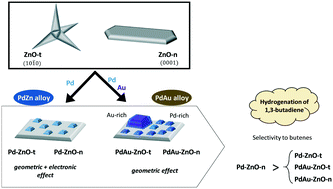Pd–Au bimetallic catalysts supported on ZnO for selective 1,3-butadiene hydrogenation†
Abstract
Bimetallic Pd–Au catalysts were synthesized using two differently shaped ZnO supports, ZnO-t (tetrapods) and ZnO-n (needles). These catalysts were tested in the partial hydrogenation of 1,3-butadiene and the results were compared to those for the corresponding monometallic catalysts of Pd. The structural and electronic properties of the catalysts were analysed by transmission electron microscopy and scanning transmission electron microscopy (TEM-STEM), Fourier transform infrared spectroscopy analysis of adsorbed CO (CO-FTIR), X-ray photoelectron spectroscopy (XPS) and in situ X-ray absorption spectroscopy (XAS) measurements combined with in situ diffuse reflectance infrared Fourier transform spectroscopy (DRIFTS). On both catalysts, gold diffusion on the Pd(111) faces and formation of small Pd-rich particles and big Au-rich core/Pd-rich shell like structures were confirmed. Besides, both Pd–Au bimetallic samples gave similar conversion and selectivity values in the hydrogenation reaction. The product distribution resembled that for monometalic Pd on ZnO-t, except for the selectivity to 1-butene among the butenes which was slightly higher. The best catalyst in terms of selectivity to the butenes is Pd–ZnO-n. The differences found in the catalytic performance were analysed based on electronic and ensemble effects. In contrast to that found for the monometallic catalysts, the support morphology does not seem to be a determinant for the properties in the case of the Pd–Au bimetallic samples.



 Please wait while we load your content...
Please wait while we load your content...